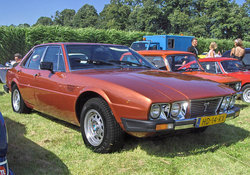Difference between revisions of "De Tomaso Deauville"
m |
m |
||
| Line 52: | Line 52: | ||
<gallery> | <gallery> | ||
| − | + | ||
| − | Image:De Tomaso Deauville.JPG|De Tomaso Deauville - Late Series 1 (14##) | + | Image:De Tomaso Deauville.JPG|<font face="Trebuchet MS" font color=black>De Tomaso Deauville - Late Series 1 (14##) |
| − | Image:Deauville2124 int.jpg|De Tomaso Deauville interior - Late Series 2 (2124) | + | Image:Deauville2124 int.jpg|<font face="Trebuchet MS" font color=black>De Tomaso Deauville interior - Late Series 2 (2124) |
</gallery> | </gallery> | ||
Revision as of 13:37, 22 April 2008

| |
| De Tomaso Deauville | |
|---|---|
| Manufacturer | De Tomaso |
| Production | 1971–1985 |
| Class | |
| Body style | 4-door sedan |
| Engine | V8 |
| Transmission | Ford C6 3-speed automatic |
| Layout | FR layout |
| Wheelbase | 2770 mm (109.1 in) |
| Length | 4851 mm (191 in) |
| Width | 1880 mm (74 in) |
| Height | 1372 mm (54 in) |
| Weight | 1940 kg (4273.1 lb) |
| Similar | |
| Fuel capacity | 2 x 60 litres (120.5 litre, 26.5 Imp gal, 31.8 US gal) |
| Designer | Tom Tjaarda under Ghia |
De Tomaso Deauville is a large four door sedan exhibited at Turin Motor Show 1970. The car featured 351 in³ (5763 cc) Ford Cleveland V8, same as used
in De Tomaso Pantera. With 330 horsepower (some later stage 270 hp) the car could reach top speed of 230 km/h (Template:Convert/mi/h)Template:Convert/test/Aon. The car could be seen as competitor to the Jaguar XJ. Although Alejandro de Tomaso took a good look at the Jaguar XJ, the Deauville was much more modern in terms of styling (comparable to the much later 90's XJ40 cars) and more sports car like.
The Deauville had independent suspension both front and rear and ventilated discs all round. The Maserati Quattroporte III was developed on the exact same chassis, both cars share e.g. suspension, shocks and differential.
Total production was 244
There were roughly 3 types of the Deauville: the early series 1 (from 1970 until 1974: serial number 10##, 11## and 12##), late serie 1 (1975 until 1977: serial numbers 14##) and the series 2 (1978 until 1985: serial numbers 20## and 21##). The differences between series 1 and 2 are minor. On technical level the engine was placed 10 centimeter towards the passenger cabine (for better weight balance), the rack-and-pinion steering was replaced with a ZF power steering and there were air louvres in both sides of the car. The rest of the changes were mainly cosmetical: interior, bumpers, placement of the scripts at back and front.
Only one station wagon was made for Mr. De Tomaso's wife. There were also a couple of amoured Deauvilles produced for the Belgian Royal Family and for the Italian government and police. One of these cars is displayed in the Museo delle Auto della Polizia Di Stato in Rome
Trivia 1: the Dutch importer Hessing sold a staggering 39 new cars in the Netherlands, that's almost 16% of the total production! Not bad for such a small country. Most of these cars are still somewhere in a garage, driving in Holland or were exported.
Trivia 2: The serial number 1040 Deauville was used in the Dutch Movie "Baantjer - Moord in Extase" as the bad villain's car. At the end of the movie the car is flipped onto its roof and completely wrecked.
De Tomaso Modena S.p.A. car timeline, 1960s–2010s
| ||||||||||||||||||||||||||||||||||||||||||||||||||||||||||||||||||||||||||||||||||||||||||||||||||||||||||||||||||||||||||||||||||||||||||||||||||||||||||||||||||||||||||||||||||||||||||||||||||||||||||||||||||||||||||||||||||||||||||||||||||||||||||||||||||||||||||||||||||

